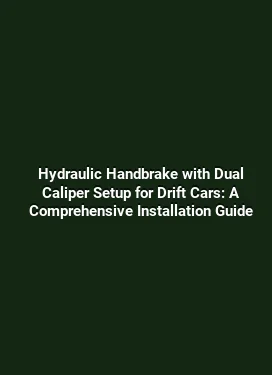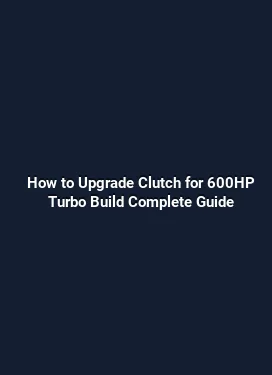Manual vs. Automatic: Which Transmission Dominates in 2026?
Transmission technology has evolved rapidly over the past decade, blending traditional mechanical design with advanced control systems. In 2026, the landscape presents a nuanced reality where enthusiast-favored manual gearboxes and highly refined automatic systems coexist, each serving distinct needs. For many drivers, the choice hinges on factors such as driving style, ownership costs, maintenance considerations, and the intended use of the vehicle. This comprehensive overview delves into the core differences, practical implications, and emerging trends shaping the states of manual and automatic transmissions in the modern drivetrain ecosystem.
Makale içindeki ilk H2 başlık buraya gelmeli

Understanding the core principles behind manual and automatic transmissions is essential before evaluating which one dominates. A manual transmission relies on the driver to operate a clutch pedal and shift gears through a finite set of ratios. This direct mechanical connection between the engine and the wheels offers a tactile, engaging experience that many drivers value. Conversely, an automatic transmission uses hydraulics, electronic controls, and torque converter technology (or dual-clutch mechanisms) to perform gear changes seamlessly, optimizing engine speed and torque delivery for varying driving conditions.
In 2026, the line between traditional manual and automatic systems has become more nuanced. Some vehicles feature semi-automatic manual gearboxes that automate clutch operation while preserving hand-shift control, blurring the distinction for buyers seeking precision without full manual intervention. The broader market, however, continues to favor automatics for everyday commuting, long-distance travel, and fleet applications due to their predictable performance, reduced driver workload, and advances in efficiency.
Makale içindeki ilk H3 başlık buraya gelmeli

To assess dominance, it is helpful to examine real-world usage patterns, market allocations, and the technology driving both categories. In many regions, automatics have captured the majority share of new-car transmissions due to superior refinement, smoother shifting, and increasingly competitive fuel economy. Manual transmissions, while shrinking in overall market presence, persist in enthusiast and compact segments where driver engagement is prioritized, lightweight architectures are feasible, and price-sensitive buyers seek lower upfront costs.
Beyond market share, practical ownership considerations play a crucial role. Automatics today often feature multi-gear sets, adaptive shift logic, and intelligent torque management that respond to driving style, load, and road conditions. Manual gearboxes, meanwhile, offer direct control over gear selection, potentially lower maintenance costs in some cases, and the satisfaction of a more hands-on driving connection for those who relish every shift.
Dominant Transmissions in 2026: What’s Leading the Way
Two broad categories shape the current landscape: traditional automatics with torque converters and the increasingly popular dual-clutch and continuously variable systems. Torque converter automatics have matured to provide near-seamless shifts, heavy-torque capability, and excellent driveability, while dual-clutch transmissions excel in rapid, sport-oriented shifting with high efficiency. Continuously Variable Transmissions (CVTs) emphasize smoothness and fuel economy, especially in urban driving and hybrid configurations. Each approach offers distinct advantages depending on vehicle type, usage, and performance targets.
From a user perspective, the choice often depends on the intended application. A performance-oriented sedan or a sports utility vehicle with a preference for quick throttle response benefits from a tightly tuned DCT. A comfortable long-haul cruiser or a city commuter, where smoothness and efficiency are paramount, may benefit more from a well-calibrated torque-converter automatic or a CVT paired with a hybrid system. The modern ecosystem also includes automated manual transmissions and semi-automatic setups, which provide hybrid control dynamics without fully relinquishing driver involvement.
Makale içindeki ilk H3 başlık buraya gelmeli
Efficiency trends in 2026 are closely linked to drivetrain architecture. Automatics with modern hydraulic controls and adaptive shift strategies have narrowed the efficiency gap with manual gearboxes in many road conditions. In hybrid models, CVTs play a crucial role by maintaining engine operation within the most efficient rpm range, while electric drive components supplement torque delivery. For enthusiasts, the tactile benefits of a manual can still translate into meaningful performance advantages in precise cornering and engine braking, particularly when paired with a responsive clutch system and short-throw shifters.
Maintenance philosophy also influences the perceived dominance of transmission types. Automatic transmissions with sealed units and complex hydraulic circuits require periodic fluid replacement and software updates, but their longevity can rival manual systems when properly cared for. Manuals, on the other hand, rely on clutch wear and linkage adjustments, which some drivers find intuitive to monitor but others may prefer to avoid due to potential labor costs and wear-sensitive components.
Performance, Efficiency, and Driving Experience
Performance metrics differ significantly between manual and automatic transmissions, yet both aim to optimize power delivery and responsiveness. Manual gearboxes grant direct engine feedback and a more linear torque feel across gears, which many drivers associate with a sportier, more-connected driving experience. This is particularly evident in cornering behavior, rev-matching techniques, and the ability to optimize torque transfer through precise gear selection.
Automatic transmissions, including DCTs and CVTs, often provide faster shift times, consistent performance across varying loads, and reduced fatigue on long drives. Modern automatics also feature adaptive shift logic that learns driver preferences, road gradient, and engine performance to deliver smoother transitions and improved fuel economy. In performance-oriented models, dual-clutch setups are tuned for rapid, nearly instantaneous shifts that preserve momentum and sustain acceleration for track-inspired driving.
Makale içindeki ilk H3 başlık buraya gelmeli
Real-world driving scenarios help illuminate the practical differences. In hilly terrain with frequent upshifts and downshifts, a manual gearbox can offer intuitive control for engine braking and gear selection, potentially enabling a more engaging descent. Conversely, in stop-and-go city traffic, CVTs paired with hybrid powertrains or torque-converter automatics with smooth torque delivery often deliver superior comfort and better urban fuel economy.
From a maintenance perspective, technicians analyze transmission fluid, clutch wear, and torque converter durability as key factors in long-term reliability. Routine inspections, fluid quality, and software calibration all contribute to performance longevity. Drivers who plan to keep a vehicle for many years may weigh the long-term service implications of each system when deciding which configuration best aligns with their ownership goals.
Cost of Ownership and Total Value
Cost considerations extend beyond sticker price to include maintenance, fuel consumption, resale value, and potential repairs. Manual transmissions typically command a lower upfront cost in many markets, which can be appealing for budget-conscious buyers. However, the long-term ownership calculus must account for clutch replacement intervals, potential labor costs, and the time value of a more involved driving experience for enthusiasts.
Automatic transmissions, especially newer generation automatics with advanced control systems, tend to have higher initial purchase prices but often offer superior resale value, reduced driver fatigue, and stronger performance consistency. In hybrid and electric architectures, the transmission design may be simplified or integrated with electric motors, further influencing total cost of ownership. Fleet applications, service intervals, and maintenance packages can also impact the overall economic picture significantly.
Makale içindeki ilk H3 başlık buraya gelmeli
Fuel economy is a pivotal factor in the 2026 market. While some automatics have bridged the efficiency gap, CVTs and hybridized transmissions often set the benchmark for urban fuel efficiency. Manual gearboxes can still deliver excellent efficiency in certain configurations, particularly when matched with lightweight chassis and efficient cooling systems. Buyers should examine real-world fuel economy data from multiple driving conditions, including highway cruising, urban stops, and mixed routes, to form a clear expectation.
Another dimension is technology integration. Modern drivetrains are increasingly connected to vehicle control units that optimize shift timing, anticipate load changes, and coordinate with traction and stability systems. This synergy enhances overall performance and safety, regardless of whether the vehicle uses a traditional manual or an automatic system.
Practical Guidance: Choosing the Right Transmission for Your Needs
Practical decision-making begins with clarifying priorities. For drivers who prioritize engagement, control, and a classic driving experience, a manual transmission remains a compelling choice in segments where it is still offered and supported by maintenance networks. For daily commuting, long-distance travel, or fleet utilization, an automatic transmission—whether torque-converter, DCT, or CVT—typically provides a more consistent and less labor-intensive ownership experience.
Assessing vehicle type and usage is crucial. Sports cars and performance sedans often leverage dual-clutch systems to maximize response times, while family sedans and SUVs benefit from the smoothness and reliability of well-calibrated automatics. In hybrid or plug-in hybrid models, CVTs or e-CVT solutions can maximize electric assist and fuel economy, providing a compelling blend of efficiency and practicality.
Makale içindeki ilk H3 başlık buraya gelmeli
Practical exercises for choosing a transmission include evaluating test-drive experiences, noting shift quality, throttle response, and the level of engine braking experienced during downshifts. It is also wise to review maintenance histories, predicted repair costs, and the availability of service in your region. In many markets, certified technicians and authorized service centers provide standardized maintenance schedules for both manual and automatic configurations, helping safeguard performance and resale value over time.
Finally, the trend toward electrification and automated driving features is reshaping the role of transmissions. As more vehicles integrate advanced driver-assistance systems, the emphasis on smooth, predictable gear changes grows stronger. This shift favors automatics and hybrids in terms of driver comfort and system integration, while still leaving room for enthusiasts who seek a traditional manual experience in select models.
Semantics of the Drivetrain: What to Look for in Modern Transmissions
Understanding the semantics of modern drivetrain architecture helps buyers interpret specifications beyond the surface. The term drivetrain encompasses not only the transmission but also the engine, driveshaft, differential, and related control software. Within this ecosystem, certain terms frequently appear in reviews and technical briefings: gear ratios, torque delivery curves, shift quality metrics, and rotational inertia considerations. Each factor influences responsiveness, efficiency, and overall driving satisfaction.
From a consumer perspective, it is beneficial to translate technical jargon into practical expectations. For example, a shorter final drive ratio can improve acceleration feel and response at the expense of highway efficiency, while a taller ratio enhances cruising fuel economy but may reduce immediate responsiveness. In CVTs, the absence of discrete gears is offset by a hydraulic or belt-driven mechanism that maintains engine speed in a narrow band of efficient operations, delivering a smooth, uninterrupted power curve for most daily scenarios.
Makale içindeki ilk H3 başlık buraya gelmeli
Another practical consideration is warranty and support. Vehicles with complex automatic transmissions may carry extended warranties on major components, reflecting manufacturers' confidence in long-term reliability. Manual transmissions, while sometimes simpler, still require attention to clutch systems and linkage wear. Buyers should consult official warranty terms and service recommendations to understand coverage for wear items and potential failures over time.
Finally, regional market dynamics can influence the prevalence of certain transmission types. In some regions, climate, road infrastructure, and driving culture affect whether manual or automatic configurations are more popular. Importantly, advances in materials, lubricants, and manufacturing processes have elevated the durability and efficiency of both categories, enabling drivers to choose based on preference and practical needs rather than being guided solely by convention.






